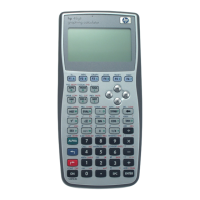Full Command and Function Reference 3-119
•
x
eye
, y
eye
, and z
eye
are real numbers that specify the point in space from which the graph is
viewed.
• x
step
and y
step
are real numbers that set the number of x-coordinates versus the number of y-
coordinates plotted.
The plotting parameters are specified in the reserved variable PPAR, which has this form:
{ (x
min
, y
min
) (x
max
, y
max
) indep res axes ptype depend }
For plot type PCONTOUR, the elements of PPAR are used as follows:
• (x
min
, y
min
) and (x
max
, y
max
) are not used.
• indep is a name specifying the independent variable. The default value of indep is X.
• res is not used.
• axes is not used.
• ptype is a command name specifying the plot type. Executing the command PCONTOUR
places the name PCONTOUR in ptype.
• depend is a name specifying the dependent variable. The default value is Y.
Access: …µ
PCONTOUR
Input/Output: None
See also: BAR, CONIC, DIFFEQ, FUNCTION, GRIDMAP, HISTOGRAM, PARAMETRIC,
PARSURFACE, POLAR, SCATTER, SLOPEFIELD, TRUTH, WIREFRAME, YSLICE
PCOV
Type: Command
Description: Population Covariance Command: Returns the population covariance of the independent and
dependent data columns in the current statistics matrix (reserved variable ΣDAT).
The columns are specified by the first two elements in reserved variable ΣPAR, set by XCOL
and YCOL respectively. If ΣPAR does not exist, PCOV creates it and sets the elements to their
default values (1 and 2).
The population covariance is calculated with the following formula:
1
n
---
x
kn
1
x
n
1
–()x
kn
2
x
n
2
–()
k 1=
n
∑
where
kn
1
is the kth coordinate value in column
n
1
,
kn
2
is the kth coordinate value in the
column
n
2
,
n
1
is the mean of the data in column
n
1
,
n
2
is the mean of the data in column
n
2
,
and n is the number of data points.
Access: …µ
PCOV
Input/Output:
Level 1/Argument 1 Level 1/Item 1
→
x
pcovariance
See also: COLΣ, CORR, COV, PREDX, PREDY, XCOL, YCOL
PDIM
Type: Command
Description: PICT Dimension Command: Replaces PICT with a blank PICT of the specified dimensions.
If the arguments are complex numbers, PDIM changes the size of PICT and makes the
arguments the new values of (x
min
, y
min
) and (x
max
, y
max
) in the reserved variable PPAR. Thus, the
scale of a subsequent plot is not changed. If the arguments are binary integers, PPAR remains
unchanged, so the scale of a subsequent plot is changed.

